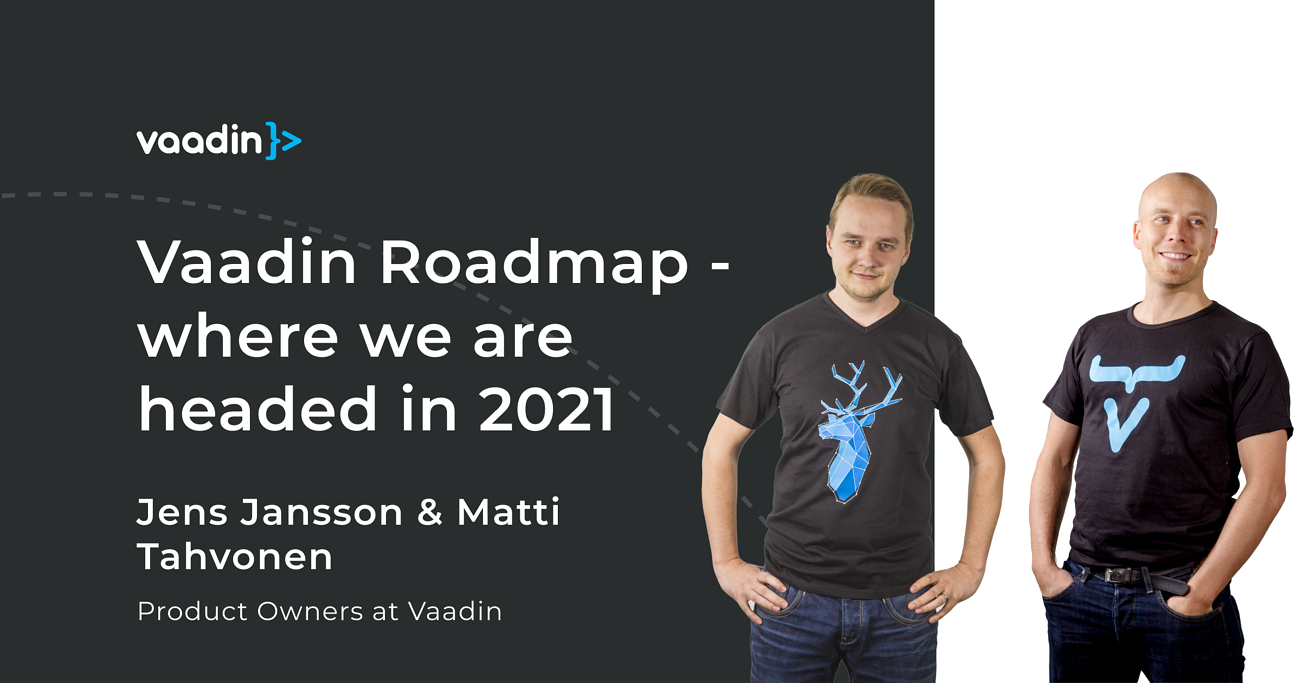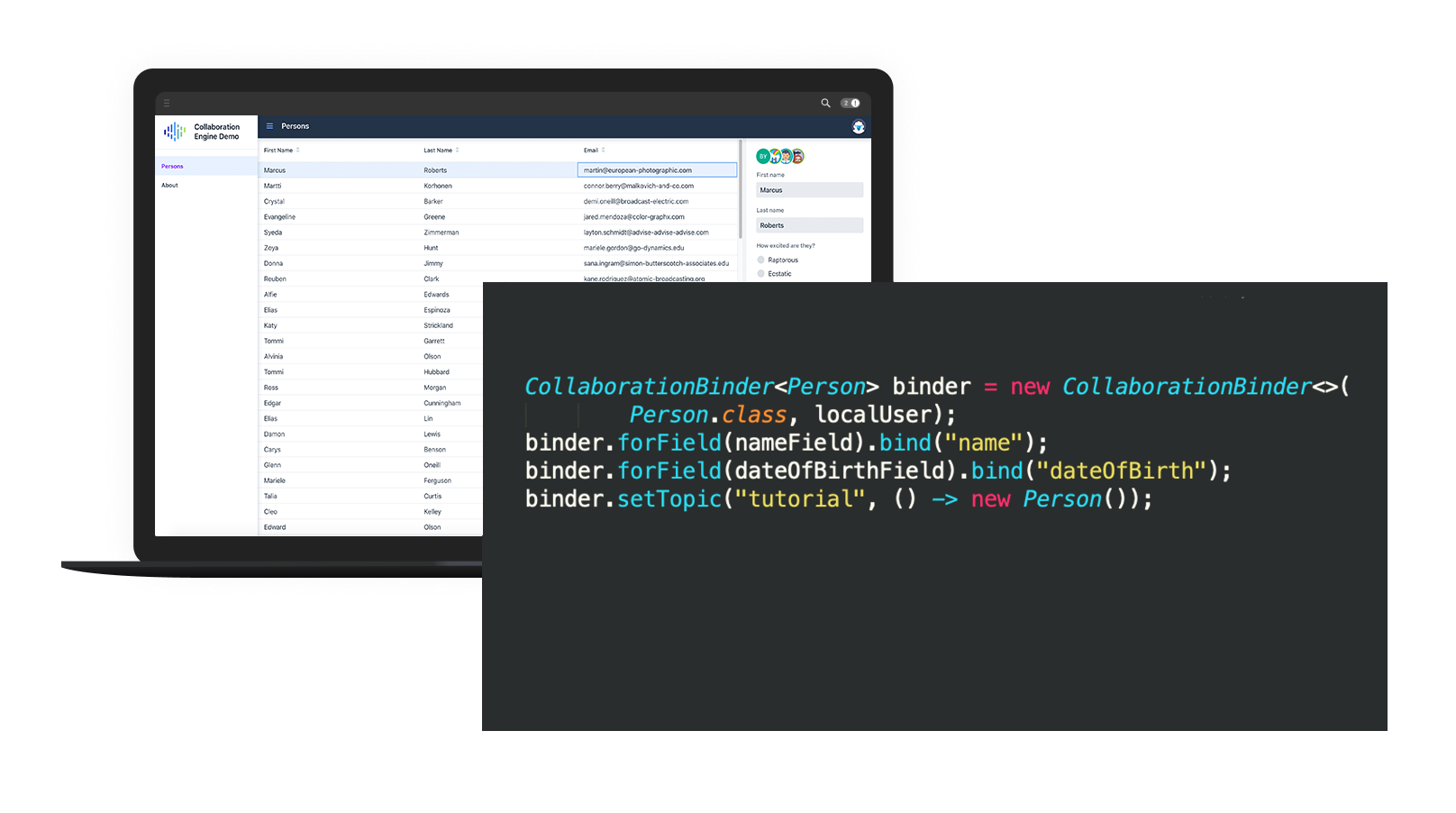Last week, I hosted product owners Jens Jansson and Matti Tahvonen for a webinar about Vaadin's 2021 roadmap. Here are the key takeaways if you haven't had a chance to watch it yet.

Although Vaadin is working on many new features this year, our core focus remains the same: helping developers be productive and build great apps.
As Jens explained, Vaadin's Vaadin believes that businesses running mission-critical apps require consumer-grade UX:
- Consumer applications tend to have bigger budgets because they are more directly linked to revenue. Because the applications generate profit, companies spend more money fine-tuning the experience of each view.
- Business apps, although often larger and more complex, have smaller budgets. Their impact on the bottom line is indirect even though they are the business-critical apps that run companies. These are apps that people use for the majority of their workdays. We believe they deserve and require better UX.
Good UX is about more than “being nice to users". It's good for business. According to a 2015 study by Forester, every dollar invested in UX brings on average 100 dollars in return. Good UX helps workers be more productive and reduces the risk of mistakes. Citibank's recent $500 million UI blunder is a perfect example of how poor UI design can impact business.
With this goal in mind have planned our 2021 roadmap to ensure Vaadin users have all tools they need to build apps that
Two frameworks with one shared goal
Many in the Vaadin community have asked us what the introduction of Vaadin Fusion means for Vaadin Flow and the classic Java API.
Even though Flow and Fusion may at first glance look quite different, they share a common goal and philosophy. Both are web frameworks built specifically for Java backends. They use the same set of components and provide you with type safety from the database to the view.
Matti explained that Flow is the framework that most customers are using, and it's the primary focus for Vaadin’s R&D team.
We have increased investment in product development, enabling us to dedicate more development resources to both Flow and Fusion. Fusion is not a successor to Flow. It is an alternative way of building Vaadin apps. There is no need to migrate Flow projects to Fusion.
Why have two frameworks? While most of our users today prefer to build applications fully in Java, many developers prefer working closer to browser APIs and work with reactive views. Fusion's client-side architecture also enables use cases that aren't possible in a server-side framework, like building offline functionality.
Flow and Fusion are compatible with each other. You can easily add Fusion-based offline views to a Flow application or build a Fusion app's admin views with Flow. It's all one Vaadin app.
The future is collaborative
The COVID-19 pandemic has drastically changed the way many of us work. It has accelerated the digitalization of work and highlighted the importance of working together, even at a distance. A recent study by Microsoft reveals that 70% of workers want to continue working remotely, at least partly, post-pandemic.
Products such as Google Suite and Figma have made real-time collaboration an integral part of how we work together on documents and designs. Vaadin Collaboration Engine helps you bring this same power to your app.
With Collaboration Engine, users can see what other users are working on in real-time. They can use built-in chat and commenting to discuss ideas in the proper context. Collaboration Engine helps you deliver consumer app UX in a business app.

Vaadin Design system delivers consistent UX throughout your organization
Another way Vaadin helps you create effective UX is with Vaadin Design System. The Design System comprises the components, documentation, theme system, and a Figma library.
The components encapsulate good UX practices and work well on different devices. We are constantly working on ensuring that they meet standards for accessibility.
The new interactive documentation site goes beyond simply listing components. It explains how and when you should use components and when other components may be more appropriate.
The Design System Publisher is a new tool that helps you build a custom design system for your company based on Vaadin's design system. You can customize the look and feel of components and add new ones. The result is a documentation site for your custom design system that helps developers in your organization follow consistent best practices.
Improved developer tooling
Vaadin Studio is a new VS Code plugin for Fusion that lets you see the UI instantaneously. We plan to let user feedback guide the roadmap, but some of the planned features are component configuration helpers, easy theme editing, and helpers for creating grids and forms. Vaadin Studio will have an invite-only alpha release in April and be available for all users a bit later.
Vaadin Designer, the drag and drop UI builder for Flow, will continue to get updates and improvements throughout the year. We are using community feedback for identifying and fixing the most critical features.
An increased focus on community feedback
Although Vaadin is working on more products than ever before, we have committed to allocating more time to working on features and issues that are important to you.
If you are a Vaadin Prime and Enterprise customer, you can access unlimited warranty bug fixes through prioritizing issues. If you are an open-source community member, you can prioritize our work by filing GitHub issues and "voting" on issues with a 👍.
We are also constantly listening to feedback from community members on the Vaadin Discord chat. We want to hear from you, so don't hesitate to reach out.
Working towards the next long-term supported (LTS) release
Vaadin's release model includes four major versions each year. Every two years or so, we mark one of these as an LTS release. LTS releases come with five years of free support, which you can extend up to 15 years through an Enterprise subscription. LTS releases are a solid and secure platform to build
Currently, Vaadin has three LTS releases that receive free updates: 8, 10, and 14. We are aiming to release Vaadin 22 as the next LTS in December 2021. Free support for Vaadin 8 is ending in February 2022.
Matti acknowledged that the Vaadin 10 release was not up to our quality standards. To remedy this, Vaadin 14 was released less than a year later as an LTS version to provide the community with an LTS release on the level of quality you expect from Vaadin.
The move from 14 to 22 is expected to have minimal API changes and should be straightforward in most cases.
See the complete 2021 roadmap
Image: do we have a graphic of major roadmap elements that would be readable?
You can find the up-to-date roadmap on vaadin.com/roadmap.
Watch the webinar recording to hear the product owners explain the roadmap in more detail and answer community questions.
